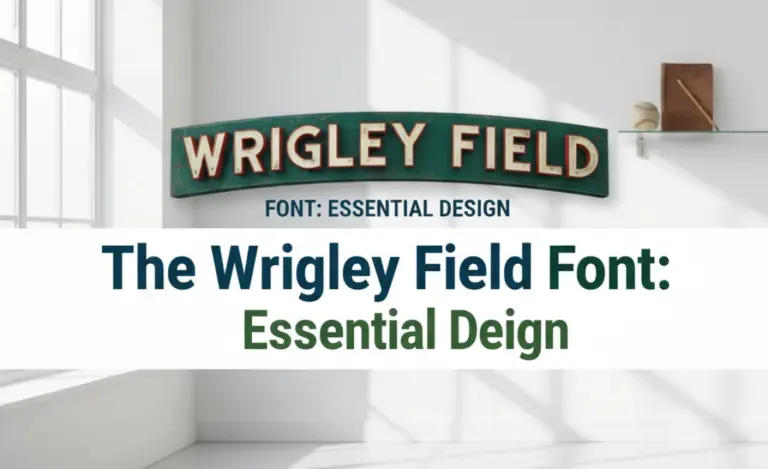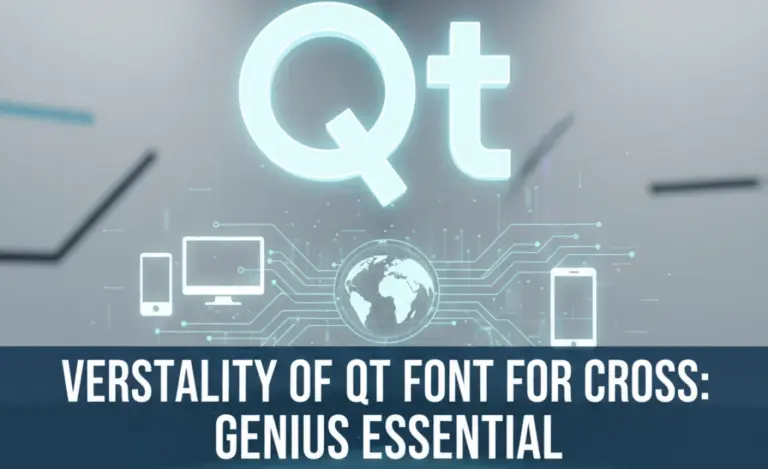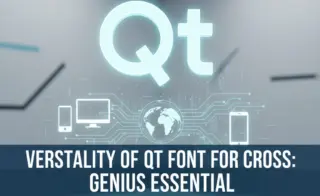Romantic fonts add elegance, emotion, and personal touch to designs, transforming text into art. This guide unlocks how to choose and use them perfectly for your projects.
Ever tried to make a design feel truly special, like a heartfelt letter or a dreamy invitation? That’s where romantic fonts shine! Sometimes, finding the right one can feel a bit tricky, like trying to pick the perfect flower. But don’t worry! We’ll walk through everything, step by step. You’ll learn how to pick fonts that whisper romance and make your designs unforgettable. Get ready to add a beautiful, emotional touch to your work!
What Exactly IS a Romantic Font?
Imagine fonts that feel like a gentle breeze, a whispered secret, or a loving embrace. That’s the essence of a romantic font! They’re designed to evoke feelings of love, tenderness, elegance, and intimacy. Unlike bold, utilitarian fonts, romantic fonts often feature softer curves, flowing lines, and a delicate, graceful presence.
Think of:
- Flowing scripts that mimic elegant handwriting.
- Delicate serifs that add a touch of old-world charm.
- Subtle flourishes that create a sense of flourish and personality.
These fonts are perfect for occasions and projects where emotion and a personal touch are key. They can make a wedding invitation feel deeply personal or a love letter truly heartfelt.
Why Use Romantic Fonts?
Romantic fonts aren’t just pretty; they serve a purpose in design. They inject personality and emotion, making your message resonate on a deeper level. Here’s why they’re such a valuable tool:
- Evoke Emotion: They inherently convey feelings of love, affection, warmth, and passion.
- Add Elegance: Many romantic fonts have a sophisticated and graceful quality, perfect for formal or upscale designs.
- Create Intimacy: They can make a design feel personal and close, ideal for invitations, personal notes, or special occasion branding.
- Enhance Storytelling: They help tell a story by setting a specific mood or tone. A vintage love story? A modern romance? The font plays a huge role.
- Stand Out: In a sea of standard fonts, a well-chosen romantic font can make your design memorable and unique.
Types of Romantic Fonts
The broad category of “romantic font” actually encompasses several distinct styles, each with its own unique charm. Understanding these differences will help you choose the perfect fit:
1. Script Fonts
Script fonts are the most common type associated with romance. They mimic human handwriting, ranging from clean and classic to wild and expressive.
- Calligraphic Scripts: These are elegant and formal, often with thick and thin strokes like traditional calligraphy. Think sweeping ascenders and descenders. They’re great for formal invitations or high-end branding.
- Casual Scripts: These feel more relaxed and friendly, like a handwritten note. They are less formal than calligraphic scripts but still convey warmth and personality. Perfect for personal blogs or friendly event invitations.
- Brush Scripts: These have a bolder, more textured look, resembling brush lettering. They offer a contemporary and artistic romantic feel.
2. Serif Fonts with Romantic Qualities
While script fonts get all the attention, some serif fonts can also exude romance. Look for those with:
- Delicate Serifs: Thin, graceful serifs can add a touch of sophistication and class.
- Softer Shapes: Fonts with rounded terminals or slightly more organic shapes can feel softer and more inviting.
- Vintage Feel: Many antique or vintage-inspired serif fonts have an inherent romantic charm, reminiscent of old love letters or classic literature.
3. Decorative & Display Fonts
These fonts are often more stylized and less about pure readability for long text. They can be highly romantic if their design elements evoke elegance, beauty, or a specific romantic theme.
- Fleur-de-lis or Swash Details: Fonts with ornamental embellishments can add a romantic, luxurious feel.
- Art Nouveau or Art Deco Styles: Some fonts from these eras have flowing lines and elegant forms that can be very romantic.
4. Handwritten Fonts
Similar to casual scripts, but often even simpler and more direct. These fonts aim to look like everyday handwriting, but with a touch of charm or artistic flair that makes them feel personal and lovely.
Choosing the Right Romantic Font: A Practical Guide
Selecting the perfect romantic font involves more than just picking one that looks pretty. It needs to fit your project’s purpose, tone, and audience. Here’s how to make a confident choice:
1. Know Your Purpose and Audience
Who are you trying to reach, and what message are you sending?
- Weddings & Engagements: Think elegant calligraphic scripts, classic serifs with delicate flourishes.
- Personal Letters & Notes: Casual scripts or charming handwritten fonts work well.
- Romantic Novels/Blogs: A more readable script or a romantic serif can be excellent.
- Valentine’s Day Campaigns: Playful script fonts or decorative fonts with heart motifs can be fun.
- Luxury Brands: Refined, subtle scripts or elegant, classic serifs.
2. Prioritize Readability
Even the most beautiful font is useless if people can’t read it! This is especially crucial for romantic fonts, as they can sometimes sacrifice legibility for style.
- For Body Text: Avoid complex scripts or highly decorative fonts for paragraphs. Stick to readable scripts or romantic-leaning serifs.
- For Headlines & Short Phrases: This is where you can get more creative with elaborate scripts and decorative fonts.
- Test Sizes: Always preview the font at different sizes. What looks great large might become an unreadable jumble when small.
3. Master Font Pairing
Seldom will one font do all the work. Pairing your romantic font with a complementary font is key for visual hierarchy and balance.
- Romantic Script + Sans-Serif: A clean, simple sans-serif is often the perfect partner for an elaborate script. The contrast highlights both fonts.
- Romantic Script + Serif: Pairing a script with a classic serif can create a timeless, elegant feel. Ensure the serifs aren’t too busy.
- Decorative + Simple: If you’re using a highly decorative romantic font for a headline, pair it with a very plain sans-serif or serif for the supporting text.
A good rule of thumb is to pair a more decorative font with a simpler one. Think of it as a star and their reliable supporting cast!
4. Match the Overall Design Aesthetic
Your font should feel like a natural extension of your design. Does your design use soft watercolor textures? Flowing lines? Minimalist elements?
- Soft & Dreamy: Rounded scripts, delicate handwritten fonts.
- Elegant & Classic: Calligraphic scripts, refined serif fonts.
- Bold & Modern Romance: Brush scripts, stylized display fonts.
5. Test, Test, Test!
Never choose a font based on a single glance. Mock up your designs with your potential fonts. See how they look on different backgrounds, at various sizes, and alongside other design elements. Get a second opinion – sometimes fresh eyes spot things you miss.
Where to Find Romantic Fonts
The internet is brimming with amazing fonts. Here are some reliable places to start your search:
- Google Fonts: A vast, free library of high-quality fonts. Search for “script” or “handwriting” and filter by style. You can find beautiful, freely usable romantic options here.
- Adobe Fonts: If you subscribe to Adobe Creative Cloud, you have access to a massive collection of professionally curated fonts, including many stunning romantic styles.
- MyFonts.com: A huge marketplace with thousands of fonts for sale, from independent foundries and larger companies. You can find premium, unique romantic fonts here.
- Fontspring: Similar to MyFonts, offering a wide selection of commercial fonts with flexible licensing options.
- Creative Market: A popular platform for designers to buy and sell assets, including unique, trendy, and often handcrafted romantic fonts.
- dafont.com: A popular source for free fonts. Be mindful of licensing for commercial use, but it’s a great place for inspiration and personal projects.
Always check the font license carefully, especially when using free fonts for commercial projects. Resources like Creative Commons provide excellent information on open licensing for creative works.
Key Characteristics of Romantic Fonts
What visual cues should you look for when identifying a romantic font? It’s often a combination of elements:
| Characteristic | Description | Effect |
|---|---|---|
| Flowing & Connecting Strokes | Letters often connect fluidly, like in cursive handwriting. | Creates a sense of movement, grace, and intimacy. |
| Elegant Curves | Smooth, gentle curves rather than sharp, angular lines. | Adds softness, sophistication, and a luxurious feel. |
| Varying Stroke Widths | Thicker and thinner parts of the letter, mimicking a brush or pen. | Adds depth, dynamism, and a handcrafted, artisanal quality. |
| Swashes & Flourishes | Decorative extensions or flourishes on certain letters or at the beginning/end of words. | Enhances decorative appeal, personality, and a sense of flourish. |
| Ligatures | Special characters where two or more letters are joined into a single glyph (e.g., ‘fi’, ‘fl’). | Contributes to a refined, cohesive, and often vintage look. |
| Soft or Delicate Details | Subtle serifs, gentle ascenders/descenders, or a light overall appearance. | Evokes tenderness, femininity, and a delicate charm. |
When to Use Romantic Fonts (And When to Avoid Them)
Knowing when not to use a romantic font is just as important as knowing when to use one!
Perfect Moments for Romantic Fonts:
- Wedding invitations, save-the-dates, and related stationery.
- Anniversary cards and love notes.
- Valentine’s Day marketing materials or greeting cards.
- Personal blogs or websites with a lifestyle, relationship, or feminine focus.
- Branding for businesses that emphasize emotion, luxury, art, or handmade goods (e.g., florists, artisanal bakers, jewelry designers).
- Book covers or titles for romance novels, poetry, or stories with emotional themes.
- Special event signage (e.g., birthday parties, baby showers).
- Quote graphics intended to be heartfelt or inspiring.
Moments to Be Cautious or Avoid Romantic Fonts:
- Technical Manuals & Legal Documents: Readability and clarity are paramount here.
- Financial Reports: These require a serious, professional, and extremely legible font.
- Long Blocks of Text (Body Copy): Most romantic scripts are hard to read in large amounts.
- Brand Identity for Highly Functional Products: Think software, hardware, or utility services. Unless the brand has a very specific romantic angle, a romantic font might seem out of place.
- Urgent or Informational Signage: Emergency exit signs, street signs, or informational displays need to be read instantly.
- Overly Corporate Branding: Unless aiming for a very specific niche within corporate, standard sans-serif or serious serif fonts are safer.
Tips for Using Romantic Fonts Effectively
Once you’ve chosen your font, here’s how to make it shine:
1. Use Them Sparingly for Maximum Impact
Romantic fonts are often best used as accent pieces. They are powerful for headlines, subheadings, or short, impactful phrases. Let them be the star of the show for a short moment, rather than trying to make them do all the heavy lifting.
2. Pair with Contrasting Fonts
As mentioned before, pairing a flowing script with a clean sans-serif or a simple serif creates a beautiful balance. The contrast helps the romantic font stand out and prevents the design from becoming overwhelming. For instance, a formal script font like Allura pairs beautifully with a simple sans-serif like Open Sans.
3. Pay Attention to Spacing (Kerning & Tracking)
For script fonts, proper kerning (the space between specific pairs of letters) is vital. Many fonts have built-in kerning, but you might need to adjust it yourself in design software to ensure letters don’t overlap awkwardly or have too much space between them. Tracking (overall letter spacing) also affects legibility. Don’t be afraid to refine these settings.
4. Establish Clear Visual Hierarchy
Use font size, weight, and style (including romantic fonts) to guide the viewer’s eye. The most important information should be the most prominent. A romantic font can be perfect for drawing attention to a key phrase or emotion.
5. Always Check Font Licensing
This is critical, especially for commercial projects. Free fonts often have restrictions. Ensure you understand how you can use the font – for personal projects, commercial work, web use, print, etc. Resources like Font Squirrel offer great guidance on font licensing.
Examples of Romantic Fonts in Action
Seeing is believing! Here are popular romantic fonts and their typical uses:
| Font Name | Type | Best For | Why It’s Romantic |
|---|---|---|---|
| Great Vibes | Calligraphic Script | Invitations, wedding stationery, elegant titles. | Flowing, classic strokes with beautiful swashes create a timeless elegance. |
| Allura | Calligraphic Script | Logos, headlines, short quotes. | Smooth, connected letters with a sophisticated feel; very readable for a script. |
| Dancing Script | Casual Script | Greeting cards, personal websites, friendly invitations. | Bouncy, informal, and warm; feels like personal handwriting. |
| Pacifico | Casual Script | Branding, social media graphics, casual designs. | Retro vibe with a friendly, approachable, and charming flow. |
| Playlist Script | Casual Script | Branding, wedding details, personal projects. | Effortlessly chic and friendly, with a natural, handwritten feel. |
| Cormorant Garamond | Serif (Romantic leaning) | Book covers, literary quotes, elegant body text (in lighter weights). | Delicate serifs, high contrast, and classic proportions lend an old-world, literary romance. |
| Lavishly Yours | Decorative/Calligraphic | Highlight text, logos, very special occasion announcements. | Extremely ornate with elaborate flourishes; demands attention and feels luxurious. |
Common Beginner Mistakes with Romantic Fonts
As you start using romantic fonts, you might run into a few common pitfalls. Being aware of them can help you avoid them:
- Overuse: Trying to make a romantic font do too much, like being body text.
- Poor Pairing: Matching a very ornate script with another busy font, leading to visual chaos.
- Ignoring Readability: Choosing a font solely on its looks without considering if it can be read easily.
- Not Testing Sizes: Assuming a






Leave a Comment